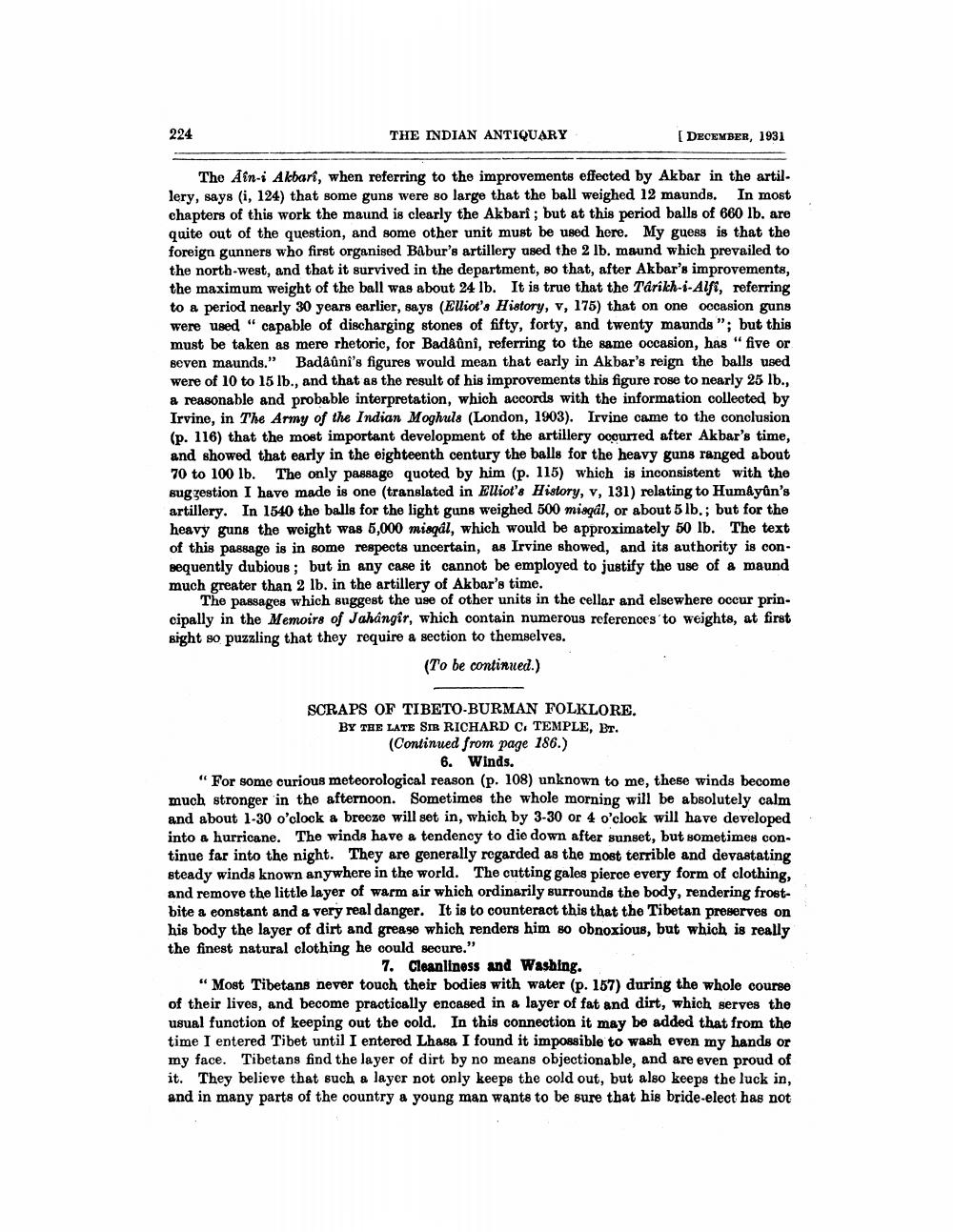________________
224
THE INDIAN ANTIQUARY
( DECEMBER, 1931
The Ain-i Akbart, when referring to the improvements effected by Akbar in the artil. lery, says (i, 124) that some guns were so large that the ball weighed 12 maunds. In most chapters of this work the maund is clearly the Akbari ; but at this period balls of 660 lb. are quite out of the question, and some other unit must be used here. My guess is that the foreign gunners who first organised Babur's artillery used the 2 lb. maund which prevailed to the north-west, and that it survived in the department, so that, after Akbar's improvements, the maximum weight of the ball was about 24 lb. It is true that the Tarikh-i-Alfi, referring to a period nearly 30 years earlier, says (Eliot's History, v, 175) that on one occasion guns were used " capable of discharging stones of fifty, forty, and twenty maunds"; but this must be taken as mere rhetoric, for Badållni, referring to the same occasion, has " five or seven maunds." Badaúni's figures would mean that early in Akbar's reign the balls used were of 10 to 15 lb., and that as the result of his improvements this figure rose to nearly 25 lb., a reasonable and probable interpretation, which accords with the information collected by Irvine, in the Army of the Indian Moghuls (London, 1903). Irvine came to the conclusion (p. 116) that the most important development of the artillery occurred after Akbar's time, and showed that early in the eighteenth century the balls for the heavy guns ranged about 70 to 100 lb. The only passage quoted by him (p. 115) which is inconsistent with the suggestion I have made is one (translated in Elliot's History, v, 131) relating to Humayun's artillery. In 1540 the balls for the light guns weighed 500 misqál, or about 5 lb.; but for the heavy guns the weight was 5,000 mieqal, which would be approximately 50 lb. The text of this passage is in some respects uncertain, as Irvine showed, and its authority is consequently dubious; but in any case it cannot be employed to justify the use of a maund much greater than 2 lb. in the artillery of Akbar's time.
The passages which suggest the use of other units in the cellar and elsewhere occur principally in the Memoirs of Jahangir, which contain numerous references' to weights, at first sight so puzzling that they require a section to themselves.
(To be continued.)
SCRAPS OF TIBETO-BURMAN FOLKLORE. BY THE LATE SIR RICHARD C. TEMPLE, Br. (Continued from page 186.)
6. Winds. "For some curious meteorological reason (p. 108) unknown to me, these winds become much stronger in the afternoon. Sometimes the whole morning will be absolutely calm and about 1-30 o'clock a breeze will set in, which by 3-30 or 4 o'clock will have developed into a hurricane. The winds have a tendency to die down after sunset, but sometimes continue far into the night. They are generally regarded as the most terrible and devastating steady winds known anywhere in the world. The cutting gales pierce every form of clothing, and remove the little layer of warm air which ordinarily surrounds the body, rendering frostbite a eonstant and a very real danger. It is to counteract this that the Tibetan preserves on his body the layer of dirt and grease which renders him so obnoxious, but which is really the finest natural clothing he could secure."
7. Cleanliness and Washing. "Most Tibetans never touch their bodies with water (p. 157) during the whole course of their lives, and become practically encased in a layer of fat and dirt, which serves the usual function of keeping out the cold. In this connection it may be added that from the time I entered Tibet until I entered Lhasa I found it impossible to wash even my hands or my face. Tibetans find the layer of dirt by no means objectionable, and are even proud of it. They believe that such a layer not only keeps the cold out, but also keeps the luck in, and in many parts of the country a young man wants to be sure that his bride-elect has not




